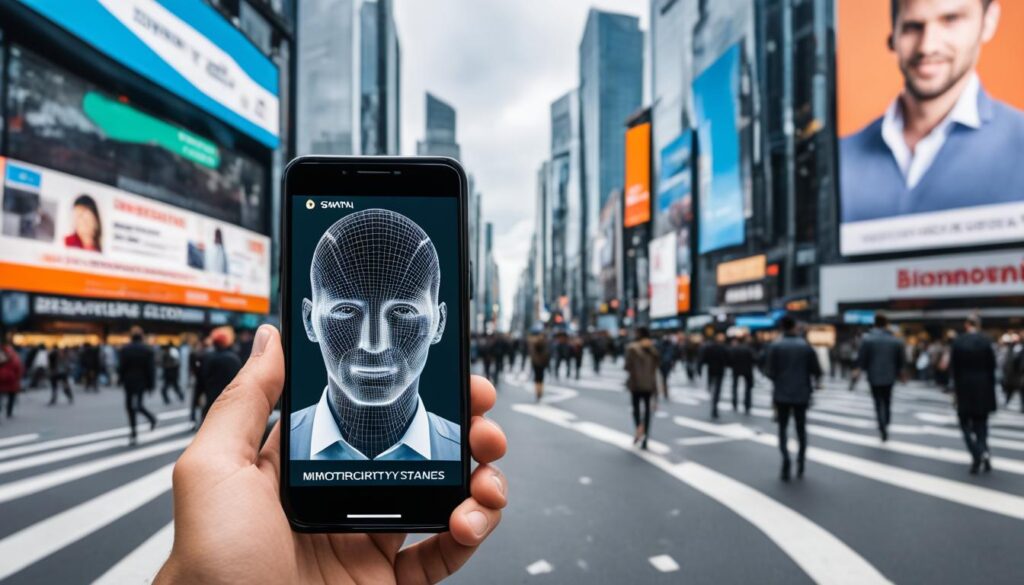Artificial intelligence (AI) has transformed the field of biometrics, specifically in the realm of behavioral biometrics. By leveraging AI technology, behavioral biometric systems can enhance security measures and verify identities with precision and efficiency. This powerful combination of AI and behavioral biometrics finds applications in various sectors, including banking, healthcare, travel, and law enforcement.
AI algorithms are trained to analyze behavioral patterns such as keystrokes, mouse movements, and voice to accurately authenticate individuals. The use of AI in behavioral biometrics enables organizations to strengthen their security measures, ensuring that only authorized individuals gain access to sensitive information and secure locations.
One of the key advantages of AI-driven behavioral biometrics is the continuous refinement and improvement of biometric algorithms. These advancements have significantly enhanced the accuracy and reliability of behavioral biometric systems, reducing the occurrence of false positives and false negatives.
The integration of biometrics with AI technology enables seamless authentication experiences. AI can quickly analyze vast amounts of biometric data, making it an ideal partner for behavioral biometrics. By combining these two powerful technologies, organizations can create convenient and secure authentication processes for users across various devices.
As AI and behavioral biometrics continue to advance, we can envision a future where this innovative combination becomes a ubiquitous part of our everyday lives. From personalized shopping experiences to accurate patient identification in healthcare, behavioral biometrics powered by AI technology offers convenience, security, and peace of mind for users.
However, as with any transformative technology, there are ethical considerations that need to be addressed. Concerns regarding privacy and biases in facial recognition algorithms must be carefully managed. Regulations that protect personal biometric data and proactive efforts to mitigate biases are essential for maintaining trust and fairness in the implementation of AI in behavioral biometrics.
In conclusion, AI has unleashed the full potential of behavioral biometrics, revolutionizing security measures and authentication processes across various sectors. While the benefits are undeniable, it is crucial to navigate the ethical implications and strike a balance between security and privacy. With responsible implementation and ongoing advancements, AI-driven behavioral biometrics will continue to shape the future of secure and seamless digital interactions.
Contents
- 1 Advancements in Biometric Algorithms
- 2 Integration of Biometrics with AI for Seamless Authentication
- 3 Ethical Considerations in Biometrics and AI
- 4 Conclusion
- 5 FAQ
- 5.1 How is artificial intelligence used in behavioral biometrics?
- 5.2 What are the applications of artificial intelligence in behavioral biometrics?
- 5.3 What role does AI play in behavioral biometrics technology?
- 5.4 How does the integration of biometrics with AI enhance authentication processes?
- 5.5 In which sectors can we expect the widespread adoption of behavioral biometrics and AI?
- 5.6 What are the ethical considerations in biometrics and AI?
- 5.7 How can we strike a balance between security and privacy in behavioral biometrics?
- 6 Source Links
Key Takeaways:
- AI in behavioral biometrics enhances security and verifies identities with precision and efficiency.
- Advancements in AI-driven biometric algorithms reduce false positives and false negatives.
- The integration of biometrics with AI enables seamless authentication experiences.
- The future holds immense potential for widespread adoption of AI-powered behavioral biometrics in everyday life.
- Ethical considerations such as privacy and bias must be addressed for responsible implementation.
Advancements in Biometric Algorithms
The field of behavioral biometrics has witnessed significant progress with the implementation of advanced AI techniques in analyzing biometric data. AI-driven behavioral biometrics analysis has proven to be a game-changer, enhancing the accuracy and reliability of biometric systems.
Researchers and developers have leveraged the power of AI to refine and train biometric algorithms continuously. This continuous refinement has led to improved precision in biometric analysis, resulting in a reduced occurrence of false positives and false negatives.
Through the advancements in biometric algorithms powered by AI, more secure authentication and verification processes have been established. These advancements ensure that only authorized individuals can access sensitive information or secure locations, bolstering overall security measures.
By harnessing the potential of AI, behavioral biometrics systems can provide robust and dependable solutions that meet the evolving demands of various sectors, including banking, healthcare, travel, and law enforcement.
Advancements in Biometric Algorithms
| Benefits of AI-driven behavioral biometrics analysis | Improved precision in biometric analysis | Reduced occurrence of false positives and false negatives | Enhanced security measures |
|---|---|---|---|
| Fraud prevention in banking | Accurate patient identification in healthcare | Streamlined and efficient travel security | Effective law enforcement measures |
| Elevated user experience | Time and effort savings in identity verification | Minimized risk of unauthorized access | Secure data protection |
These advancements highlight the potential of behavioral biometrics powered by AI to address the complex challenges faced in today’s digital age. From preventing fraud in banking to ensuring accurate patient identification in healthcare, AI-driven behavioral biometrics analysis offers a multitude of benefits.
By combining AI techniques with behavioral biometrics, organizations and individuals can take advantage of cutting-edge technologies that enhance security, provide a seamless user experience, and safeguard sensitive data.
Integration of Biometrics with AI for Seamless Authentication
The integration of biometrics, such as facial recognition, with AI technology is revolutionizing authentication processes. AI has the capability to analyze vast amounts of biometric data quickly and efficiently, making it an ideal partner for behavioral biometrics. By combining these two powerful technologies, seamless authentication experiences can be created for users across various devices. This integration enhances convenience for users while strengthening security by reducing the risk of unauthorized access.
Improved Authentication with AI and Behavioral Biometrics
Utilizing AI in behavioral biometrics allows for more sophisticated authentication methods that go beyond traditional passwords and PIN codes. By incorporating biometric data, such as facial features, voice patterns, or fingerprints, AI algorithms can accurately verify individuals’ identities. This advanced level of authentication offers enhanced security against identity theft and fraud.
AI-driven behavioral biometrics analysis can detect subtle patterns and behaviors that are unique to individuals, such as typing speed, mouse movement, or gesture patterns. By continuously learning from these behavioral cues, AI algorithms can build accurate user profiles and detect anomalies. This enables real-time identification of suspicious activities and enhances the overall security of authentication processes.
Multi-Device Authentication Made Easy
The role of AI in behavioral biometrics extends beyond traditional authentication methods. With AI-powered biometric systems, users can seamlessly authenticate themselves across various devices, eliminating the need for multiple passwords or authentication tokens. By analyzing unique behavioral patterns, AI algorithms can recognize individuals regardless of the device they are using, creating a consistent and user-friendly authentication experience.
For example, Imagine logging into your banking application on your smartphone in the morning, and later accessing the same account on your laptop. Thanks to AI and behavioral biometrics, you won’t have to enter additional login credentials or go through cumbersome verification processes. The system can effortlessly recognize your unique behavior and grant you access to your account, ensuring a seamless and secure user experience.
The Future of Authentication
The integration of biometrics with AI technology offers a glimpse into the future of authentication. As AI continues to advance, the capabilities of behavioral biometrics will further evolve. This powerful combination has the potential to revolutionize not only user authentication but also identity verification in various sectors.
The following table illustrates the potential applications of AI and behavioral biometrics in different industries:
| Industry | Potential Applications |
|---|---|
| Banking | – Seamless and secure login to online banking platforms – Fraud detection and prevention – Enhanced customer experience |
| Healthcare | – Accurate patient identification and record access – Secure remote patient monitoring – Prescription fraud prevention |
| Travel | – Contactless and secure airport check-ins – Biometric boarding passes – Improved border control and passport verification processes |
| Law Enforcement | – Facial recognition for identifying suspects – Real-time video surveillance and anomaly detection – Efficient crime prevention and investigation |
The integration of AI and behavioral biometrics is set to transform the way we authenticate ourselves and secure our digital identities. As technology continues to evolve, we can expect these advancements to bring improved security, convenience, and trust to our everyday authentication processes.

Healthcare organizations are also leveraging the power of behavioral biometrics and AI to improve patient identification and enhance the overall quality of care. By utilizing AI algorithms, healthcare providers can accurately match patient records, ensuring that the right treatment is administered to the right individual. This technology not only streamlines administrative processes but also reduces medical errors and enhances patient safety.
Implementing behavioral biometrics and AI technology in everyday life offers convenience, security, and peace of mind for users.
In the travel industry, AI-powered behavioral biometrics is revolutionizing airport security processes. Facial recognition technology can be used to quickly verify the identity of passengers, allowing for seamless boarding and reducing long queues. This not only improves the overall travel experience but also enhances security by detecting potential threats more effectively.
Law enforcement agencies are also tapping into the potential of behavioral biometrics and AI to enhance public safety. Facial recognition technology can aid in identifying suspects, preventing crimes, and ensuring the safety of communities. By analyzing behavioral patterns and biometric data, AI-powered systems can assist in investigations and provide law enforcement officials with valuable insights.
| Industry | Application |
|---|---|
| Banking | Secure and seamless authentication through behavioral biometrics |
| Healthcare | Accurate patient identification and improved quality of care |
| Travel | Efficient airport security processes and seamless boarding |
| Law Enforcement | Enhanced public safety through suspect identification and crime prevention |
The integration of behavioral biometrics and AI technology is transforming the way we interact with everyday systems and services. From unlocking our smartphones using fingerprint or facial recognition, to personalized shopping experiences tailored to our preferences, this innovative combination has become an integral part of our lives. As technology continues to evolve, the widespread adoption of behavioral biometrics and AI holds tremendous potential to further enhance convenience, security, and overall user experiences.
Ethical Considerations in Biometrics and AI
The use of biometrics and AI raises ethical concerns regarding user privacy and bias in facial recognition algorithms. Collecting and storing personal biometric data poses potential privacy risks, especially if security measures are compromised. Additionally, facial recognition algorithms can be susceptible to biases, resulting in discriminatory outcomes.
Protecting user privacy is paramount when it comes to biometrics. The collection and storage of personal biometric data should be done with utmost care and adhering to strict regulations. Organizations must prioritize secure storage practices and implement robust encryption techniques to safeguard this sensitive information.
Moreover, bias in facial recognition algorithms is a significant concern. The algorithms used to train and deploy facial recognition technology may exhibit biases that disproportionately affect certain individuals or groups. These biases can lead to discrimination and exclusion.
To mitigate biases, developers must actively address this issue. A key solution lies in using diverse training datasets that represent a wide range of demographics. By including data from various racial, ethnic, and gender groups, developers can reduce bias and improve the accuracy and fairness of facial recognition algorithms.
Regular evaluations and audits should also be conducted to identify and correct any biases that may emerge over time. These evaluations ensure that facial recognition technology remains unbiased and equitable in its application.
Stricter Regulations for Privacy Protection
Stricter regulations are needed to protect the privacy of individuals in the realm of biometrics and AI. These regulations should outline the specific guidelines for data collection, usage, retention, and security measures.
Implementing stringent regulations can help establish a transparent environment for the use of biometric data, ensuring that individuals have control over their personal information and that it is used only for legitimate purposes.
Organizations should also obtain explicit consent from individuals before collecting and using their biometric data. This ensures that individuals are aware of how their data will be used and have the right to refuse or withdraw their consent.
| Privacy Concerns in Biometrics | Bias in Facial Recognition Algorithms |
|---|---|
| Collection and storage of personal biometric data | Disproportionate impact on certain individuals or groups |
| Potential privacy risks if security measures are compromised | Discrimination and exclusion due to biased algorithms |
| Stricter regulations needed for data protection | Use of diverse training datasets to mitigate biases |
| Explicit consent for data collection and usage | Regular evaluations and audits to identify biases |

Conclusion
In conclusion, the integration of artificial intelligence in behavioral biometrics has transformed the way we approach security and authentication. By harnessing the power of AI technology, behavioral biometrics systems have witnessed significant advancements in accuracy and reliability, leading to enhanced user experiences. From banking and healthcare to travel and law enforcement, AI-driven behavioral biometrics has found its applications in various sectors, ensuring robust security measures and trustworthy verification processes.
Despite the numerous benefits, it is essential to address ethical considerations such as privacy and bias in order to responsibly implement this technology. Stricter regulations should be enforced to protect personal biometric data and prevent any compromise in security. Additionally, developers must actively work towards mitigating biases in facial recognition algorithms by diversifying training datasets and conducting regular evaluations.
As technology continues to evolve, we can expect behavioral biometrics powered by AI to become an integral part of our daily lives. The convenience, security, and trust it offers in our digital interactions will undoubtedly play a significant role in shaping the future of authentication and identity verification.
FAQ
How is artificial intelligence used in behavioral biometrics?
Artificial intelligence is used in behavioral biometrics to enhance security measures and verify identities. Machine learning algorithms are harnessed to analyze and interpret vast amounts of behavioral data, improving the accuracy and reliability of biometric analysis.
What are the applications of artificial intelligence in behavioral biometrics?
Artificial intelligence in behavioral biometrics has applications in various sectors such as banking, healthcare, travel, and law enforcement. It can be used in identity verification processes, access control systems, personalized shopping experiences, and accurate patient identification in healthcare.
What role does AI play in behavioral biometrics technology?
AI plays a crucial role in behavioral biometrics technology by enabling the efficient analysis of biometric data and the development of advanced algorithms. Through machine learning techniques, AI can continuously refine and train these algorithms, improving the precision and security of behavioral biometric systems.
How does the integration of biometrics with AI enhance authentication processes?
The integration of biometrics, such as facial recognition, with AI technology revolutionizes authentication processes. AI can quickly and efficiently analyze vast amounts of biometric data, creating seamless authentication experiences for users across various devices. This integration enhances convenience while strengthening security measures.
In which sectors can we expect the widespread adoption of behavioral biometrics and AI?
Behavioral biometrics and AI are already being implemented in various sectors such as banking, healthcare, travel, and law enforcement. From secured access to banking services to accurate patient identification in healthcare, these technologies offer convenience, security, and peace of mind for users.
What are the ethical considerations in biometrics and AI?
Biometrics and AI raise concerns regarding user privacy and bias in facial recognition algorithms. Collecting and storing personal biometric data can pose privacy risks if security measures are compromised. Additionally, biases in facial recognition algorithms can lead to discriminatory outcomes. Stricter regulations and diversity in training datasets are essential to address these concerns.
How can we strike a balance between security and privacy in behavioral biometrics?
Striking a balance between security and privacy involves establishing clear boundaries regarding data collection, storage, access, and usage. Robust encryption techniques and giving individuals control over their biometric information can help maintain security while respecting privacy rights.




